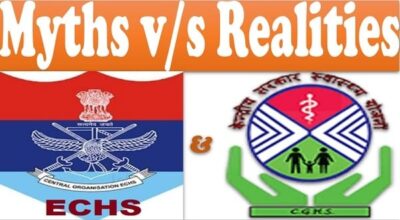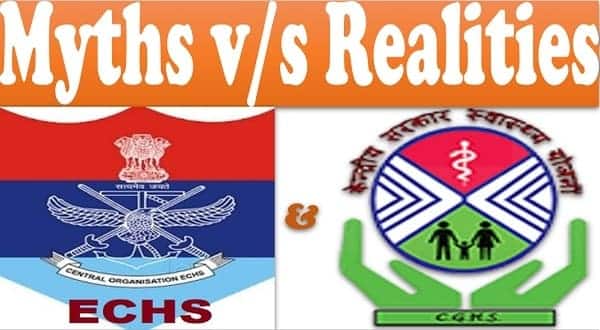CGHS and ECHS: Myths vs Realities

CGHS & ECHS: MYTHS VS REALITIES
1. Many veterans do not gain the optimum from ECHS due to ignorance about the scheme and its rules. Such ignorance also leads to comparison of the ECHS with CGHS, a parallel Central govt scheme meant for civilian central govt employees. While ECHS is intended only for retired military personnel, CGHS is a common scheme for serving and retired civilian central government employees. An objective analysis of FACTS will clarify all the ambiguities leading to unfair comparisons between the schemes. Here are some myths regarding the issue and the fact checks.
2. Myth 1. ECHS has imposed so many checks and controls that it has strangulated the system.
Reality. ECHS follows all policies of CGHS. All the referral rules for OPD/IPD/Inv are the same as CGHS. There are no deviations in ECHS.
3. Myth 2. The IAS who formulate policies for CGHS do not distrust BSF, CRPF or Home ministry personnel whether they are getting referred to a hospital once or twice and do not question which medicines or tests and why, once the Doctor has written or prescribed it.
Reality. Even ECHS does not question any prescription written by the Doctor of an empanelled hospital. The medicines given by the Polyclinic are of Generic nature which is also the case in Wellness Centres of CGHS.
4. Myth 3. CGHS has a better polyclinic network compared to ECHS. The ECHS polyclinics are over staffed in comparison to CGHS Polyclinics, while the only requirement at a polyclinic is a doctor sitting with a printer to give referrals. Besides visiting patients’ veracity are checked by many suffocating controls ranging from Biometrics to Aadhar etc.
Reality. ECHS has more polyclinics (433) than the CGHS which has about 327. Staff in an ECHS polyclinic is lesser than that of a CGHS polyclinic. The PC is not just a referral centre. It is mandated to provide Primary Healthcare and therefore has qualified doctors in its staff who examine the patients. All the patients do not need referral are treated and prescribed medicines. Only patients who require secondary or tertiary care under a specialist or a super-specialist are referred to empanelled hospitals.
The checks on veracity of visiting patients are to control fraud and Aadhar Authentication is being gradually introduced as per directions of Ministry of Electronics and Information Technology, Govt of India, to introduce two-factor authentication in all Central Govt welfare schemes. Failure of Aadhar authentication due to some reason will not lead to denial of services as alternatives are in place.
5. Myth 4. The ECHS OICs are behaving as “Thanedaars” rather than enablers for visiting veterans. The men in uniform were never told this at the time of enrolment or commission that after a particular quota of money for medicines at a polyclinic gets exhausted, they will have to fend for themselves. Otherwise, they would have procured private health insurances which are not available to them now in sunset years.
Realities. The ECHS OIC is also a veteran and a beneficiary of the scheme. ECHS is taking all steps to ensure veteran friendly OIC with good knowledge of ECHS rules and regulation is appointed. The ECHS is a cashless capless scheme which covers OPD/IPD including medicines, which no insurance scheme allows. It is a misnomer that insurance allows you complete reimbursement.
6. Myth 5. ECHS should provide better facilities than CGHS or wind up and either revert to MH/CH/RR or merge with CGHS (veterans will be better off than ever changing policies at the whims and fancies of our senior brass). Government should encourage Jawans and Offrs to buy medical insurance for their sunset years rather than keeping them in dark.
Realities. _ ECHS is run as per the directions of the Mod (DESW), Govt of India. ECHS provides all facilities as CGHS and follows all rules as per CGHS, as laid down by the Govt. of India. No policy can be changed without a government order. It is a misnomer and fallacy that policy can be changed at will. No insurance policy gives the cashless and capless cover as ECHS. Insurance is a personal choice. Even in case beneficiary utilises a private insurance policy, ECHS will provide the balance claim amount not passed by insurance.
7. Myth 6. One of the biggest drawbacks is the limited number of empanelled hospitals and the availability of specialists in certain areas. This can lead to challenges in accessing a wide range of medical services, especially for those residing in remote or rural areas where the network of empanelled hospitals might not be as extensive.
Realities. ECHS has more empanelled hospitals than CGHS. While the CGHS has 2248 empanelled Hospital the ECHS has about 3500. ECHS has polyclinics and empanelled hospitals in hilly and most remote places in India.
8. Myth 7. Additionally, there have been concerns about the bureaucratic processes and delays in settlements of medical claims. The scheme is designed to be cashless, but sometimes, due to administrative issues, beneficiaries might have to pay upfront and then go through a reimbursement process, which can be cumbersome.
Realities. Medical treatment in empanelled hospital is cashless. The veterans are not supposed to pay any cash unless they opt for a higher grade implant or procedures. Even if the veteran has to pay the bill, it is reimbursed as individual reimbursement.
9. Myth 8. The rates determined by CGHS are often cited as not covering the operational costs of hospitals.
Realities. It is a Central Govt order that ECHS will follow CGHS rates. All Hospital which get empanelled concur to this rates. Recently, the following rates have been increased:
- ICU rates
- Consultation rates
- Room rent
- Cardiology
- Surgical rates
A committee is looking into the rates for further revision. ECHS has good network of approximately 3500 empanelled hospitals including top corporate hospitals, service hospital and reputed govt hospitals like AIIMS etc. for veterans’ care. 10. Myths 9. The biggest advantage of the Central Government Health scheme (CGHS) is its comprehensive coverage and cost-effectiveness. It provides complete healthcare facilities to central government employees and pensioners, ensuring access to quality medical services without financial strain. Some key benefits: Cashless Treatment, Wide Network (over 12,000 government and private hospitals across India), Family Coverage. These are not there in ECHS.
Reality. All advantages are equally applicable to ECHS.
11. Myths 10. CGHS Wellness Centers are the foundational elements of the Central Government Health Scheme (CGHS). They function as the primary healthcare facilities for beneficiaries of the scheme, offering a range of medical services eg Outpatient Services, Medicines, Diagnostic Tests: Basic diagnostic tests and check-ups, Health Education, Referral Services: Referrals to empanelled hospitals for specialized treatment. Our ECHS polyclinics do not matchup to this.
Reality. All such facilities are available at ECHS Polyclinics.
12. Myths 11. Each CGHS Wellness Center is headed by a Chief Medical Officer (CMO) and is responsible for the healthcare services provided to CGHS beneficiaries. The centres operate during specific hours on all working days, and some even offer emergency services beyond regular hours. The Wellness Centers are strategically located across various cities in India to ensure that beneficiaries have access to healthcare services without significant travel. They are a crucial part of the CGHS, ensuring that government employees, pensioners, and their families receive timely and effective medical care. In the Central Government Health Scheme (CGHS), the referral system allows beneficiaries to be referred to empanelled hospitals and specialists for further treatment.
Reality. All such facilities are available at ECHS Polyclinics. In ECHS, the head is an OIC Polyclinic and not a doctor. Rest all are similar in CGHS and ECHS.
13. Myths 12. While CGHS does not have its own polyclinics, it operates through a network of Wellness Centers which act as the primary point for outpatient services and referrals. The referral process has been simplified over time to reduce inconvenience and delays in treatment. For instance, referrals from CGHS Wellness Centers to empanelled hospitals are valid for 30 days and can be used for consultations up to three times within this period at the same hospital.
Reality. The CGHS Wellness centre and the ECHS Polyclinic are similar in every way. All referral procedures are same as CGHS.
14. Myths 13. The CGHS has made provisions for beneficiaries to be referred through video calls, and if a beneficiary is unable to visit the Wellness Center, they can send someone on their behalf with the necessary documents to obtain the referral. This simplification of the referral process is aimed at making healthcare services more accessible and efficient for CGHS beneficiaries.
Reality. The E-Sehat is being rolled out and it would reduce the grievances of veterans. Moreover patients in emergency can directly go to Hospital rest have to come to ECHS for taking a referral. Patients above 75 years of age can directly go to empanelled hospital without referral.
15. Myths 14. The number of veterans is going to only increase, and the system will kill itself in our life time. That would happen when we will need it most. I have seen ESMs being turned away in emergencies by empanelled hospitals and also by service hospitals.
Realities. ECHS is taking proactive steps to cater to the increase in veteran over the years with initiatives like upgradation of polyclinics, opening of new polyclinics in new places, Veteran Wings and Hospital, Emp of AIIMS and other reputed hospitals. DGAFMS has given clear direction that veterans will not be turned away from service hospital. ECHS will take strict action against empanelled hospital who refuse the veteran admission.
****
View/download the PDF
COMMENTS